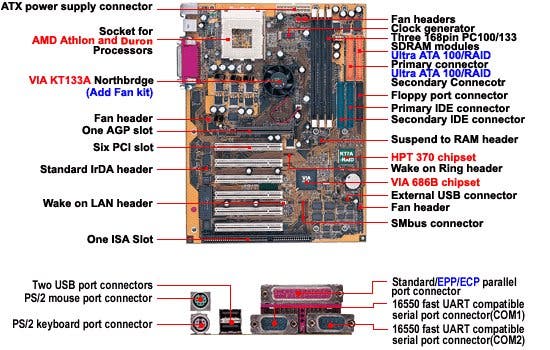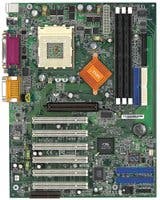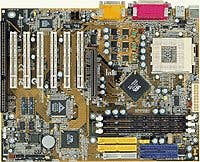April's Marching Motherboards
Article - Four of the finest examples of the KT133A Athlon motherboard chipset, put head to head
VIA's "KT133A" motherboard chipset has really taken off, just as we predicted it would, with every major manufacturer of motherboards from ASUS to IWill now offering an Athlon solution based upon it. With so many gamers looking to cash in on the recent price reductions in 'classic' SDRAM and the Athlon itself, the KT133A has become the most popular option for upgraders. With this in mind, it seemed prudent for us to take a look at a few of the most popular competing KT133A platforms and compare their pros and cons for the average home user. On the lab bench are, in no particular order, the ASUS A7V133, the ABit KT7A-RAID, the IWill KK266R and the MSI K7T Turbo. The best way, it seems, to judge a motherboard is no longer its performance relative to its competitors, but how many options there are in its BIOS, how well it will cope with current and future generations of Athlon, and how user-friendly it is. As such, we'll give each motherboard a score out of ten, made up of 1-3 points in each of these areas, and then a bonus point where we deem appropriate. To get a good grounding on the KT133A chipset itself, we suggest you read our previous appraisal.

ASUS A7V133 - £125
You may recall last year when we gave ASUS' previous Athlon offering, the vanilla A7V, a glowing report. As it was obvious even then that the performance difference between Athlon motherboards was negligible, we cited rock solid stability, user-friendliness and value-added extras like its seven (count 'em) USB ports before awarding it 9/10. Like most of the boards in this roundup, the A7V133 scores similarly well in both of the latter two categories, because fundamentally it is the same board with a chipset upgrade. However, we find it impossible to give the A7V133 as high an accolade as its predecessor received, due to what seem to be inherent and unsolved issues with the board's stability. To be fair, it is early days, and BIOS updates may solve a few issues, but this is the story so far. During our brief acquaintance with the A7V133, we tested Windows Millenium and Windows 2000 stability using our standard tools. Various Athlons were used, overclocking attempted and whatnot, but even using the strictest and healthiest BIOS options and jumper settings, we found it impossible to achieve a consistent level of stability in Windows 2000. And we found this to be rather confusing, because none of the other 'boards in this roundup had problems with the NT-based operating system. The A7V133 is a nicely laid out motherboard, with its side-on Socket A packaging (to allow for easy install and removal of the Athlon or Duron processor), and generous spacing between components. With seven USB ports available in total it scores very highly with peripherists (you just made that up, didn't you? -Ed), but no matter what steps we took, unexplained problems with Windows 2000 dogged us from start to finish. The 'board might be fine for a couple of hours, then crash five times in succession using Internet Explorer. A few hours of hardcore gaming gave it no problem, but copying and pasting between Notepad windows hard-locked it. One point that was raised was the possibility that changing state quickly and spontaneously was causing the KT133A chip itself to overheat, but the impressive, active cooling of a heatsink and fan on the chip would suggest otherwise. Reinstalling the duo with a thin layer of thermal transfer goop made no difference either. A frustrating time was had, then. Windows Millenium performance was shame-facedly good, with our test Athlon running at 7x133 (933MHz), utilizing the new 133MHz front side bus. The chip had no problem running with such a low multiplier, unlike one of the others in our roundup. Like the other 'boards in this roundup, the A7V133 features an IDE RAID controller, from Promise. Confusingly though, it only offers support for RAID 0, striping, and not RAID 1, mirroring. The MSI 'board in this roundup supports both using the same controller, so this seems absurd. The board also lacks an ISA slot, favouring a CNR one, despite the incredibly small number of devices capable of making use of it. The conclusion then, seems to be that if you rely or feel you may ever rely on Windows 2000, the A7V133 may not be the 'board for you right now. The reliance on dip switches for things like multiplier and front side bus is rather old hat now also, and it loses points based on that. A strong worker then, but dogged by issues that frankly ASUS ought to have sorted out in the intervening period between the A7V and now. 6/10, with no bonus point.

ABit KT7A-RAID - £130
One of the jewels in this roundup, the ABit KT7A-RAID is a bastion of convenience. Featuring virtually every option under the sun in its Award BIOS, it takes the strain off those who get a little flustered dipping under the bonnet all the time and puts the power in the hands of the armchair user. Or something. Unlike its companions, the KT7A-RAID requires no jumper fiddling at all. Beyond resetting the BIOS with a jumper, the 'board needs no intervention at all, in fact. Once an "unlocked" Athlon is installed, everything from multiplier and front side bus to AGP speed and memory timings can be changed. ABit offer a unique "SoftMenu III" solution to its BIOS users, which enables them to tweak every little variable. Important memory options like 4-way DRAM bank interleaving (a real performance booster) are also included. The ability to tweak the CAS latency and individual memory timings mean that people with high performance memory (such as that supplied by Crucial or Kingston) can take advantage of it. Of the 'boards in this roundup, the KT7A-RAID features the most comprehensive BIOS. On the downside, as stock it comes with two annoyances. Firstly, there is a safety feature which shuts down the PC within a couple of seconds if the rotational speed on the CPU fan drops below a certain figure. This is to prevent overheating. It's useful, too, but unfortunately, some people don't actually use the three-pinned fan header, and there is no option to disable the setting. Another annoyance is that our test Athlon (running at 7x133) would not work! This is because at any multiplier lower than 8.5, the 'board will not boot with a 133MHz front side bus. Thankfully, both this and the above problem can be cured with a BIOS flash (to a more recent version), but this is still quite an inconvenience, and weighs heavily against the KT7A-RAID's virtues. Speaking of virtues though, one is the inclusion of IDE RAID thanks to a Highpoint controller. Like the original KT7-RAID, the KT7A-RAID allows users to create drives "arrays" using multiple disks for either better performance of instantaneous backup. Useful, and certainly something to endear it to power users. Although some had concerns about the Highpoint controller in days of yore, we could find nothing to fault it on the KT7A-RAID. It's fair to say that the KT7A-RAID is the best overclockers' 'board, but even so, we actually achieved better stability at higher speeds with the final two motherboards in our roundup... Our final point, anyway, has to be about user-friendliness. Unfortunately, the 'board's Socket A packaging is physically quite close to the top, and prevents easy heatsink and fan installation/removal, thanks to its proximity to the power supply. Other than that though, with four USB connectors in total and a neat layout, it scores very well. 7/10, with no bonus point.

MSI K7T Turbo - £120
Microstar have a firm history of crafting mature chipsets into strongly-performing motherboards. Their "BX Master" motherboard was appropriately named, offering the best possible performance and features of any Intel 440BX chipset motherboard, over two years after its introduction. Although younger than the BX chipset, the KT133A is already of an esteemed lineage, and so is the K7T Turbo. Although performance wasn't really an issue we took much into consideration during these tests, it bears noting that the K7T Turbo was fractionally ahead of its competition. It also proved the most stable under all tests, even enabling us to run our Athlon at 7.5x133 (in other words 1GHz) for more than ten minutes under tortuous conditions. Also in its favour is the inclusion of a Promise IDE RAID controller. Similar to the Highpoint controller found on the ABit motherboard, the Promise allows users to create disk arrays for whatever purpose they select. The interface is reasonable, but we prefer the Highpoint. The K7T Turbo has a couple of flaws, most notably its reliance on jumpers, where its competitors are at least using dip switches and usually the BIOS. Setting the clock frequency via jumpers is arduous and fairly boring, and inflexible compared to the ABit 'board. If you know the limits of your chip of course, stability will be the most important aspect of the equation. The other puzzle is the inclusion of a CNR slot over an ISA one. MSI have made the same decision as ASUS here, and it's one we find baffling. Many people still rely on ISA for networking or a modem, and will be naturally then be drawn to either the KT7A-RAID or the next 'board, the IWill KK266R. Leaving out ISA is a startling oversight, we think. Ultimately though we think the MSI is one of the best 'boards in this roundup. Although its layout is a touch inhibitive, like the ABit motherboard, it makes up for it in other areas, namely stability and overclocking capability. Definitely not as thorough in its BIOS options as the KT7A-RAID, but better in other areas, and at the end of the day it scores the same. 7/10, with no bonus point.

IWill KK266R - £165
The new kid on the block. The KK266R is a feature-packed motherboard from IWill, a company whose history in this area is actually sprinkled with flaws. Many users have complained to us about IWill motherboards and niggling problems. From our experience with the KK266R however, there are very few in this release. The most impressive feature is support for a multiplier of 15. All of the other 'boards in this roundup feature support for multipliers up to 12.5 only. A multiplier of 15 will allow users to insert higher speed Athlons, codenamed Palominos, which were recently shown off at CeBit in Hannover, Germany. This makes the KK266R an extremely wise choice for those keen on keeping the same motherboard for a reasonable period of time. The motherboard aims to cater to the two types of Athlon, the 100 and 133MHz FSB chips, separately. There is a single FSB jumper, which can be set to a default speed of 100 or 133 depending on your chip. From there, you can tweak the front side bus using IWill's "Smart Setting" menu. Change the multiplier, the front side bus, the core voltage, and more. In actual fact, the most favourable addition is the ability to "lock" the BIOS to outside intrusion. You can change its attributes in the Setup facility so that it can not be flashed - therefore preventing the more malicious virii out there from attacking it. Although the layout of the motherboard is a touch clumsy, with the Socket A packaging very close to the top of the 'board, this flash-lock feature scores high for it in user-friendliness. In terms of support for current and future Athlons, as well as user-friendliness, the KK266R is the pick of the bunch, it would seem. Its BIOS is laden with enough features to keep power users happy, although the presence of any jumpers at all is a bit of a disappointment. IDE RAID is provided, with support for all the popular flavours, and it works a treat. Two extra USB connectors are also catered for, but the panel for them is an optional extra not included by default. The only two things one could really cite as a chink in the KK266R armour is its memory settings. Although it's possible to enable DRAM bank interleaving and change the CAS latency, other memory timings are few and far between. The other issue here is one of price. Of the boards featured in this roundup, the IWill is the newest and most expensive. It's got a lot going for it, but it costs upwards of £160, with the ASUS, its nearest in terms of price, a whole £25 less at its most expensive. The price will drop, but slowly, while people who don't really care about IDE RAID can pick up a plain KT7A for just over £100, and benefit from its excellent array of BIOS options. That said, if price isn't a consideration, it wins. 8/10, including a bonus point for the extra multipliers above and beyond its competition.

Conclusions
As our resident hardware nutcase, it's my job to offer opinion and reason to back up my musings. As an owner of the IWill KK266R and ABit KT7A, half of my bed is made, but as it turns out, as my comments above indicate, I favour the IWill. The KT133A is a surprisingly mature chipset considering its age, and there will no doubt be many more motherboards based upon it released within the next year. With SDRAM prices looking quite stable (despite a possible recovery on the OEM PC market front), and Athlon prices sliding downward as new speed chips are released, the next important step is a budget 'board which features the functionality of the ABits and IWills of this world, for half the price. Although there are pretenders using rival chipsets, the KT133A so far lacks a champion in this field. All of the 'boards on display here are good performers, and on average, the IWill comes out on top. There may be other factors that dissuade you from it, particularly perhaps the lack of extra USB connectors by default, or the price, but in the long run, it should pay for itself. And if you don't buy it... I will!
:-

